A Look at Rivet Saddles
When I last corresponded with Debra Banks, she was off to ride the Texas Rando Stampede 1200 - a 750 mile brevet that she would go on to complete in 85 hours. Naturally Deb did this on a Rivet: a waterproof, slotted leather saddle of her own design.
While Rivet saddles are fairly new to the scene, Deb's experience in the industry goes back to her time at Selle Anatomica. In her own words:
Tom Milton, the founder of Selle An-Atomica was my sweetie and after his untimely death, I ran SAA for a year while his estate was being settled. His family took over the company and I ventured out on my own to form Rivet Cycle Works.
At the moment, Rivet offers three basic models of saddles in different widths. Each is available in a range of colours, and with a choice of cro-moly or titanium rails. We discussed my trying one for review and settled on the Pearl.
Named after Pearl Pass in the Rocky Mountains, the Rivet Pearl saddle was optimised for long distance comfort and support. As Debra explains, this does not mean these saddles are solely for long distance riders. Rather, if a cyclist experiences saddle discomfort when attempting longer rides, it was designed with addressing this in mind. The Pearl model features bag loops for attaching a full sized saddlebag.
Measuring 170mm at the rear, the width of the Pearl is equivalent to that of Selle Anatomica saddles. However, the shape and structure are quite different. In fact, while Rivet saddles may invite comparisons to Selle Anatomica because of the shared history, I find them to have more differences than similarities. The list of similarities is short: Both are slotted, and both are made of waterproofed leather in largely the same range of colours. However, the form and feel have little in common.
The first thing I noticed about the Pearl before fitting it on my bike was how tall it was. The height, or depth of a saddle is not a spec that all manufacturers list, but it matters. While the Pearl's leather upper is in itself shallow, the rails are pretty deep. Installing it in place of my Berthoud Touring saddle, my seatpost had to be lowered almost a full cm to compensate. Selle Anatomica saddles are even shallower than Berthoud, so the difference there would be greater still. I am not comfortable providing exact figures, because height is difficult to measure and I don't want to misinform. But basically it's Selle Anatomica < Berthoud Touring < Rivet Pearl, with just under 1cm of difference in height between each.
It occurs to me that the purpose of the deep rail design on the Pearl might be to avoid any chance of the leather hitting the rails should it stretch over time. There is certainly no danger of that. The wrap-around tab on the underside further reduces tension loss.
According to Debra, Rivet saddles can take about 300 miles to break in, during which time they may also stretch. The tension screw should be used to regulate tension - not just in the event of stretching, but also to find the tension that works best for the rider's anatomy.
The purpose of the slot on Rivet saddles is "to relieve pressure and help to re-distribute pressure to other areas, depending on how the rider sits on the saddle." The Rivet slot is a bit longer than the slot on the Brooks Imperial line of saddles, and considerably shorter than Selle Anatomica's.
The edges of the Pearl's sitting surface are crisply delineated, rather than rounded, which gives it a sculptural look. The "R"-embossed rivets add textural interest. The Burgundy colour, pictured here, is a deep brown with a magenta tint (and, from what I can tell, identical to Selle Anatomica's Mahogany).
For waterproofing, a chemical agent is mixed into the tanning process (a different process than what is used for vegetable tanned leather). To increase firmness and minimise sagging, a second layer of leather is laminated to the upper piece. The leather for Rivet is sourced from Wisconsin, then sent to Taiwan, where the saddles are made by a master craftsman. Rails and other frame parts are sourced from Taiwan. The saddles are assembled there and then shipped worldwide.
With the demo Pearl on my roadbike, I rode around the neighbourhood and determined that the standard (highest) tension felt pretty good. The rear felt just about right at my sitbones. The transition from rear to nose felt just a tad wider than what I normally ride. With this initial assessment I felt comfortable enough to try a long ride.
I tested the Pearl on an informal 100K. Including my ride to and from, it was an 87 mile day in the saddle. For me, the Pearl out of the box did not require a break-in period. I experienced no soreness over the course of this distance. The leather felt quite stiff, but suppler than my hard-as-a-rock Berthoud. Compared to a Selle Anatomica, the "hammocking" action was subtle, and I could not discern independent movement between the two sides separated by the slot. The curvature and surface of the Pearl's rear felt very comfortable as the miles rolled on. Once in a while I could feel the ridges of the slot toward the front. It was not enough to cause chafing in the course of the distance I did, but I wanted to note that I could feel them. What did cause chafing - and this started around mile 60 - were the sides of the saddle in that transitional part that tapers toward the nose. Given the location and nature of the chafing, this was not a breaking-in issue or a tension issue, but a structural issue - the Pearl model is slightly too wide for me in the rear-to-nose transition, which caused chafing to my inner thighs over time. Having received my feedback, Debra agrees with this diagnosis and suggests I try the narrower Independence model to compare.
As we all know, preferences in saddle shape, size and feel are highly personal. It is always good to have options and variety. Designed by an experienced randonneuse, the saddles from Rivet Cycle Works are a welcome addition to Brooks, Berthoud and Selle Anatomica. The Pearl model is priced at $150 with cro-moly rails and $250 with titanium rails. In addition to saddles, Rivet also offers handlebar tape, mudflaps, and other goods. I wish Deb all the best with the business, as well as in her cycling adventures.


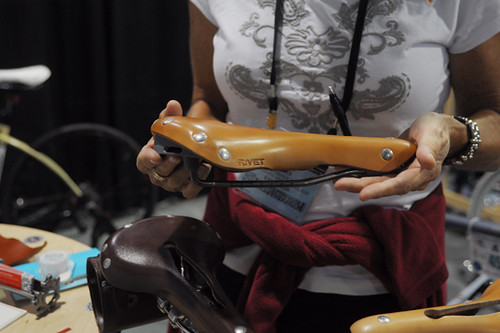
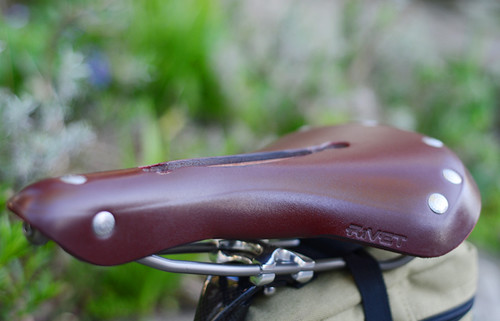

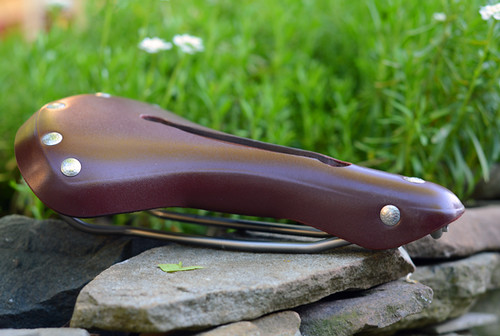

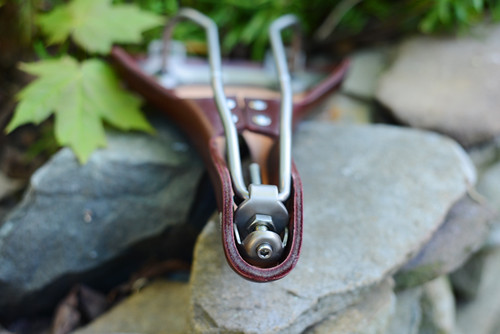




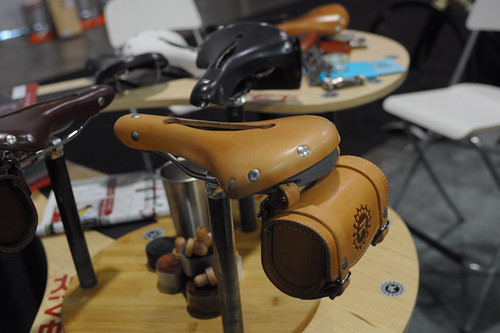
Of course there is a hammocking effect - all saddles do this. All saddles vary in rail to surface height; no one measures seat height to the rail. Accurate measurement includes factoring in sag (hammocking).
ReplyDeleteSome riders prefer hammocking; I think the rail stack height might preclude this but may serve (does serve) the function of suspension. After all the longer the rails the longer the lever the more flex.
Yes let me rephrase the hammocking part.
DeleteDuh. Those who ride very small frames and those trying to suck some life out of a frame basically too large for them pay very close attention to rail height. Recently I put a 4'11'' rider on a very ordinary 19-1/2" 3spd and rail height was definitely part of the equation. It was a good fit too. No standover problem on a ladies frame.
DeleteWith no personal reason to pay much attention I have noticed a handful of saddles over the years that had enough hammock to ground out on the rails. And then there are the setups where a vintage bike is best suited to a straight post and old fashioned saddle clamp. On that setup it is quite common to hammock down to the top of the seatpost. Hence some saddles are made with lots of height.
If the saddle can hammock right down to the top of a straight post and the saddle has a big slot on top a prudent designer is going to measure rail height and they will make that saddle nice and tall.
DeleteThank you for this! The detailed description is very helpful, as are the pictures.
ReplyDeleteOne question, I do not see any plastic parts on your saddle. Can you confirm there are no plastic parts?
Liddy
There are no plastic parts that I can see on the Pearl model; the rails are either cro-moly or titanium.
DeleteThe Independence on the other hand "uses a composite resin frame" - i.e. plastic like on the Berthoud.
So, I'm thinking of getting up the courage to approach my local bike shop and ask for a demo saddle. I mean, it's cool that you get a chance to demo these products and offer some observations but, as you say, saddles are a personal kind of experience and as you noted before you were quite surprised that three different women, all about the same size, had bikes that were so different in feel and fit. The bike shop is sure to offer opinions, like you, based on their experience but I'm more concerned with MY experience and would love to have a saddle for a week or two before dropping the cash. It's frustrating.
ReplyDeleteIf it helps, Wallingford Bikes offers a 6 months(!) unconditional return policy on Brooks. Not sure about Berthoud, which they also carry.
DeleteI know, I've got two Brooks saddles from Wallingford, each with a different feel than the other even though they're the same model. They are very friendly and I like their policy but it's cumbersome to ship back and forth which is why I prefer to support local shops. Problem is they rarely stock things because it's so easy to get them from the internet.... I'm thinking of moving away from leather and would love to sample other options.
DeleteI think you'd find that having a well-stocked bike shop around, or even being an industry "reviewer" only gets you so far. You still have to ride the things, try them for different distances and experience all the painful problems before getting it right, if at all. I do not own a perfect saddle, though the two I use (Berthoud and SA) are the least problematic of what I've tried so far, and I am grateful enough for that. And I bought them before all this demo samples stuff. After I'd bought and sold about 5 others.
DeleteAlso, remember that once you find a saddle you like, God forbid you change your bike position significantly, because you might have to start from scratch.
Brooks and variation: My experience as well. Hence my road saddles are not Brooks. I am told to try the Pro as that seems the most consistent, but I have not done so yet.
Synthetic vs leather: One way in which I am really lucky, is that we have a bike shop here (RSC) that stocks demo bikes with all sorts of road and racing saddles and they lend the bikes out for test rides. To everyone. I have not found a synthetic saddle yet that felt good after 10 miles, 20 max. But every time I see a new one there I keep trying. Sometimes it's hard to know even when to start. I can't stand gel, for instance. But the ones without gel tend to be too narrow.
What can I say, at this point I would ride a pink and purple noseless leopard print plastic saddle with slinkys for springs if I thought it'd help!
Brooks pro = SAA/rivet NOT!
DeleteRSC has no Spesh saddles. They are different.
You don't stand much; this will always be a prob.
Your butt ain't tough enough yet.
I've tried one, but it had gel in it. What model does Mrs. GRJ use?
DeleteAlias 143 - given to her by her fitter. Non-women's specific. No gel, foam.
DeleteAddendum - she's using my old brooks pro on her commuter now - it's great after I molested it ice the course of 4 years.
Thanks, I'll check it out.
DeleteIn the old days a well stocked bike shop was easier. There were less options and there was no internet. Manufacturers today have a different terrain to navigate and so do consumers.
DeleteThis review was timely. I was just looking at your saddlebag post and zoomed in on the saddle because I did not recognize it. I have been having issues with my Brooks and inner thigh chafing lately so I may take a flyer on a rivet.
ReplyDeletethey had me until made it taiwan... already tried a cardiff thanks
ReplyDeleteThis saddle is nothing like a Cardiff. Here's a post about those.
DeleteIt's clear these aren't Cardiffs or Gyes or VOs. But, I still can't see shelling out $150 for this thing when a SAA is $159 (That NSX jawn is going on one of my impending builds) or when B17s go for sub-$100. Apples to oranges and all of that; all of these saddles are only superficially similar, but If I'm going to pay thru the nose, I'd rather know that some of my money is going to the labor. At $150 for the Taiwanese chromo-rail version, I know that there's disproportionately more money going into shipping and gross profit for the folks on the top at Rivet.
DeleteIMO it's not helpful to focus on where the saddle is made before meeting the basic premise of whether it does what we want it to do (i.e. not make us bleed on rides over X distance). Now if we find 2 saddles that are equivalently comfortable, then sure we have the luxury of talking about country of manufacture, aesthetics, etc., but not before. And this review is oriented at "before."
DeleteThe saddles you mention are honestly not comparable. A B17 is shaped completely differently from a Selle Anatomica from a Rivet. The price diff should not be the factor governing the selection.
i think there's a trend these days to be aware of where a product comes form.
DeleteI am very conscious of it too. I am only saying that functionality has to come before that consideration.
DeleteSaw a funny segment on the Colbert Report which suggests surprising thoughts on the ways in which one purchases commodities.
DeleteAs we all know, Brooks makes a wide variety of saddles in a plethora of shapes. I just brought up the B17 to bolster my argument: it's cheap.
DeleteEveryone has their own priorities; "we" must remember that when "we" tell one another how to think. For me, any purchase I make, I want to consider the social implications and choose accordingly, if possible. If something is very cheap and I'm feeling stingy, I can get over the slave-wages thing. If something is expensive, it's too bitter to swallow.
Functionality is important, too, but I'm sure the SAA (which shares a lot of design elements with the Rivet) is a functional choice. And, I think we can all agree that Brooks makes a very functional saddle.
I like Brooks and am biased for, rather than against Brooks.
DeleteThe B17 I cannot ride, it is to wide. The B17N, Swallow and Swift (tried them on friends' bikes) are too narrow. I've tried a vintage Pro and it felt horrible in a way I can't even describe - but I think in retrospect this may have been due to a ridge down the middle. So I'd like to give that model another chance.
My brooks pro was still in great shape after six years. But for some inexplicable reason we no longer get along. So I Bought a SAA saddle a few months ago when the factory had a sale.
DeleteThe saddle is more comfortable than my brooks pro. But I was a slightly underwhelmed by the finish, durability, and customer service from SAA. After less than 300 miles I've used 85% of my tension adjustment. Customer service was no help. Fit and finish on my brooks pro was perfect,on the SAA underwhelming given the similar price.
From reviews, seems rivet might be a better quality saddle at a similar price. I'm soon to be in the market for a saddle again . Doubt I'll give my money to SAA just because they're made in the U.S.
The Brooks pro is so far the best fitting saddle I've ridden for a 45-degree or steeper back angle, and I have one on most of my road bikes.
DeleteI loved my brooks pro. But for some reason it stopped getting along with my butt after years of harmony. Tried adding tension and taking away tension. Tried angling slightly nose up, slightly nose down, and level.
DeleteTo add about my SAA experience, I'm not the most observant person. So if quality issues don't escape my notice they have to be pretty noticeable. Such as ragged unfinished edges and sloppy rivet work. Wouldn't be the first product to change for the worse after leadership of the company changes.
"You still have to ride the things, try them for different distances and experience all the painful problems before getting it right, if at..."
ReplyDeleteYes, that's my point. Most places don't allow product trials unless you're lucky enough to know the owners....One sorta has to be an insider, which is frustrating for the average buyer.
When I pedaled across the country a few decades ago, my saddle of choice worked because I worked at a bike shop at the time and had access to the trial and error experience....It allowed for no problems.
When I did triathlons the issue was less important b/c time won out over comfort and most saddles were interchangeable.
Now as a daily commuter and one who still puts about 600 miles a month on the bike I'm finding it frustrating in dealing with bike shops who prattle on and on about design but won't let you try one w/o buying it. So I continue to search for something worthy of the price asked.
What is the policy of Rivet saddles? How do they invite potential buyers to sample their saddles?
You got me curious. went to their website. Sounds pretty good.
Delete"The Rivet Guarantee
We want you to go your distance. If you purchased your Rivet from a bike shop, contact them as you are working under their shop policies. If you bought it directly from Rivet, you have 365 days to contact us and figure out what’s wrong or needs changing. During that time we will take back your saddle no questions asked. Please know that if you contact us on the 366th day of ownership, you will have to make a good case to the Head Riveteer."
http://rivetcycleworks.com/caring-for-your-rivet/
OT but just wanted to say how brave you are for taking a new saddle on a 100K like it's no biggie. You've come a long way and you are blossoming into a great reviewer.
ReplyDeleteThank you TJ. But the downside to this, is that it makes me less sensitive to problems beginners might experience on shorter rides.
DeleteI remember talking to a randonneuring pal about saddles a few months back. She talked about her history and issues and preferences and I found it very useful, until at the end she said something like "Of course under 100 miles it doesn't matter. Anything will do for a hundred miles."
Really?? Well not for us mere mortals! I think that if I ever start to feel that way, it will be no less of a problem than a reviewer who never does over 20 miles.
Velouria, with all due respect you are wrong about that. The trick is to gain experience, but retain the analytical skill and know-how to put yourself in a beginner's shoes. Your pal is not a professional reviewer for a reason. I hope you have what it takes!
DeleteI have never seen these saddles IRL but from what I see here (and read on their website) they look beefier (i.e. uglier), are heavier (600g for a standard Cr-Mo version. Wow!) are available in fewer colors and are more expensive than An-Atomica. Where is the advantage then? Are you find them superior in comfort to An-Atomica? If not - why bother?
ReplyDeleteI don't (not the Pearl at least). But someone else might. That would be the advantage.
DeleteI should revise the above.
DeleteIn some ways I prefer this saddle - namely the firmness and the particular shape of the rear. However, I prefer Selle Anatomica's "independent movement" and rear-to-nose transition. We can't always have it all.
Without having the samples in hand it's important to note weight can connote durability - thicker leather, larger diameter/thicker rail walls.
DeleteDurability - yes. One reader confided in me that he rides a Selle Anatomica and simply replaces it every year after the leather stretches beyond re-tensioning. He does a lot of miles though, 6K+ year.
DeleteAlso, as far as leather thickness - bostonbiker, keep in mind that SA has a model for regular riders and another for heavier riders (Titanico X). Looking at the leather on the latter I suspect it is the same 2-ply laminate as on the Rivet. I'll ask them though to make sure.
Replacing a saddle every year is not that shocking if you ride lots. How many miles are on yours, Velouria? Any wear and tear?
DeleteHard to say, because I am bad at keeping track of milage and also switch them between bikes, as well as try other saddles occasionally.
DeleteAn estimate: 3K on the Berthoud and 2K on the SA? Maybe.
The Berthoud is kind of improbable as far as leather saddles go. Hard as the day I got it. Wear and tear is mostly just sweat stains (eew I know), and scrapes from me dropping the bike. No stretching, like zero. Also, I've gotten it wet and it has not deformed - though I understand on longer rides (multiple hundred miles) that is a danger.
The SA - no wear or tear, but it constantly sags. Pretty resistant to scratches and abuse though and totally waterproof in a downpour.
The funny thing is that people who don't ride all-leather saddles assume that they're all the same. As your review shows, there are great variations in shape and height within brands and even models--let alone between them!
ReplyDeleteWhether or not it's a saddle I'd choose, I'm always glad to see more choices. After all, as Velouria points out, saddle preferences are very personal, so what I wouldn't ride might be someone else's dream saddle. I recall how, in my racing days, some riders swore by the banana-shaped Concor saddles. I think I lasted about 50 km on one!
More choices are always a mixed bag...Many are crap--knock offs--and some have true innovation and potential value to the consumer. Let the buyer beware!
DeleteVelouria what do you think of short nose or women's saddles? I have not seen those mentioned here in some time.
ReplyDeleteSpeaking generally: For city bikes I find them a must. For road bikes I find them a must-not.
DeleteThe short nose is very helpful for riding in a skirt or long coat. otherwise I find the garment catches. And the more generous width works nicely with an upright position.
On a roadbike, I prefer the full/long nose, finding it helpful for steering and balance. This is increasingly so as I learn to steer with my hips more. Also the women's saddles tend to be simply too wide for a road position - both Brooks and Berthoud.
I like the look of leather saddles but they hurt. I bought a Velo Orange sprung saddle that was thick. I found it just uncomfortable. The Brooks saddle I purchased was more comfortable but only for about 5 miles at a time. I do prefer a longer nose than the one on the women's Brooks B67 sprung saddle.
ReplyDeleteBased on the post I think the answer is yes, but just to make sure -- Did you have your Berthoud Touring and Selle-Anatomica installed on the same bike and was your position the same? trying to make sure no other factors could account for the thigh rub.
ReplyDeleteYeppers.
DeleteDesdemona with the SA
Desdemona with the Berthoud (her usual state)
Saddle fit is personal, true, but one cannot generalize about leather saddles. You have to try them, and reposition them to get the fit correct. My understanding is that the Brooks saddles are most difficult to break in, but the SA saddles are pretty stretchy after a relatively short time. I happen to ride three bikes with Rivet saddles, two cromoly Pearls and a titanium Indy. For me, they work really well, but the Pearls took about 200 miles to break in. My wife has a Pearl, too. I rode it first to do the break in, but she loves it!
ReplyDeleteBrook's Aged saddles are softer leather and break in more quickly, almost straight out of the box. But they don't last quite as long as the 'standard' models. I suppose leather saddles are a lot like leather shoes. You can buy soft leather trainers and they're comfortable right out of the box but might only last a couple of years and may not be that comfortable after a very long walk. Good leather boots may take longer to break in, but once broken in will be comfortable all day long and last decades (with the odd replacement sole). Basically the softer and more stretchy the leather then in theory the leather wont last as long as a tougher less stretchy one but breaks in more quickly. I would think 'any' stressed leather saddle will be better than a gel one though.
DeleteI know this blog leans hard towards products in current production. There comes a time when the continuous round of musical saddles just stops being a game you want to play. Then you get the Ideale. A few years back entry to Ideale land could cost crazy cash. Now you can get most anything for the same cost as a new-production model. Or less if you know how to shop. And one Ideale 90 or 92 definitely costs less than a boxful of new saddles.
ReplyDeleteThis business of saddles that only last a season is nonsense. I just bought a B18L to put on a 1949 Hercules ladies Sports Model. The saddle has to be a decade older than the bike. Great saddle. Has many many years left. 69 Euro, full asking price, no haggle.
I think the biggest problem with reviewing leather saddles is they take a fairly long period of time to break in, so it's hard to review them unless it's over a very very long period. Though i suppose with a modern gel saddle it may be great for a few hundred miles then terrible after that.
ReplyDeleteThis saddle looks like a more nicely finished version of the Taiwanese Gyes gs-06h (https://www.youtube.com/watch?v=Br7Fv1mCb8s) with a slightly different cut-out. The Gyes costs about $70.
ReplyDeleteI've used Brooks, Ideale and now Selle Anatomica saddles. All have been fine. There are differences between leather saddles, but I think these pale in comparison to setup issues. A 1 cm movement fore or aft or a few degrees nose up or down changes everything.